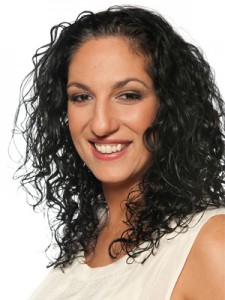It wasn’t but several years ago when a Google search for “gay Muslims” or “lesbian Muslims” turned up few results on actual people, mainly just pages on why homosexuality is a sin in Islam and perhaps one or two articles, usually focusing on men. Since then there’s been an increase in profiles on people who struggle to reconcile — or not reconcile — the two identities. Films like Parvez Sharma’s A Jihad for Love (2007) and the Channel 4 documentary Gay Muslims (2006) have added to coverage on the topic.

- Aliyah on her wedding day. Image via LA Times article.
Recently the LA Times ran a story on 22-year-old Aliyah Bacchus, who faces this struggle. Writer Erika Hayasaki introduces the topic thus: “Aliyah Bacchus returns home to offer a choice: Accept her sexuality — as she has — or lose her forever.” She recounts Aliyah’s story: wearing the abaya to high school, her unhappy marriage at 17, and her realization and identification as gay.
Hayasaki tells Aliyah’s story in third person, her diction literary and descriptions detailed. Considering the personal nature of the mini-biography, which describes Aliyah’s thoughts and feelings, there is a surprising lack of direct quotes from Aliyah herself.
The dramatically-told story builds up to final confrontation. Aliyah tells her aunt (who raised her after her mother died) that she loves a woman, a non-Muslim at that. Her aunt’s disapproval of homosexuality has not changed. Hayasaki writes,
“Salam o aliukum,” her aunt tells her. May the peace and blessings of Allah be with you. I’ll pray for Allah to forgive you, she tells Aliyah, before getting into her van.
This phenomenon reminds me of one described by blogger Muslim Hedonist, now Crypto-Muslim:
Just as we were taught to be; be as nice as you can to your relatives, but don’t compromise Islamic principles. Support people as much as you can, but withhold from wrongdoers the pearl of great price—acceptance, belonging. In the end, you hold them at arm’s length.
Aliyah leaves, and flies to Arizona with the woman she loves. She hasn’t communicated with her family since.
Building up to the final conversation that determines a lifelong decision makes a dramatic story, but it leads to a predictable ending. Who really expects a conservative family like Aliyah’s to accept a daughter living as a lesbian? You don’t even have to be someone who arranges her 17-year-old daughter’s marriage to be opposed to her being gay. And the added factor of her aunt’s view of homosexuality as fundamentally immoral doesn’t help matters.
The problem with articles on gay Muslims is that they often paint a distinct binary of the Muslim identity as constraining, conservative, and judgmental, and the gay identity as free, liberating, and natural. There’s a reality that developed this stereotype, but it’s not quite that simple. When a gay Muslim throws off her Muslim identity because it conflicts with her gayness (as some Muslims do), it’s not as though all the problems of being gay disappear and life is suddenly easy. And it’s certainly not as though families, if only they weren’t Muslim, would accept a gay child. It’s true that many Muslims and many immigrants don’t view homosexuality favorably, but it’s not a position that’s unique to these communities, even when it may be more prevalent in them.

This story presents an ultimatum, but it shows family, not Islam, as pitted against Aliyah being gay. There is no mention of Aliyah leaving Islam — in fact, the article notes that she, along with her non-Muslim partner, fasted during Ramadan, and tries to lead an upright, charitable life. Hayasaki makes no judgments on Aliyah’s religiosity or what constitutes true Islam. Near the end of the article, there’s a reference to two bottles of “red Russian champagne.” There is no explanation of whether these are Aliyah’s or Stella’s and whether Aliyah drinks alcohol.
The article is accompanied by a photo (above right) of a crosslegged Aliyah, laughing. In contrast to the wedding picture (above left) provided as related content, in which she is dressed in all white, only her face showing, in the recent picture Aliyah wears a tank top and sweatpants. I don’t want to linger on clothing too much, since it’s an over-discussed topic as it is, but I wonder: was the tank top, which shows a bit of her lower back as well as the usual areas tank tops don’t cover, chosen specifically to illustrate a drift from conservative Islam? In the story, Hayasaki describes Aliyah’s post-abaya look as an ankle-length black trench coat, sunglasses, piercings, and tattoos. Perhaps there could be some elaboration on how Aliyah’s self-realization led to the new look, especially since in high school she had stuck to the abaya “as if daring the world to take her on.” It can’t be as simple as “all lesbians have tattoos.” Did she lose the hijab/abaya the same time she cut her hair and said goodbye to her husband? Does it reflect a rejection of letting her family decide for her?
Despite the fact it reads like a novel, Hayasaki’s article is a good one, giving a peek into the struggles of being gay and Muslim and showing that one can attempt to reconcile religion, if not family. I would be interested in reading more about Aliyah, in her own words. Beyond this article, I’m curious if there’s a perhaps a story somewhere of someone who isn’t forced to choose between two strict worlds. Where are the Muslims who are gay and, though they may struggle, don’t give up on their families or their religion?
Editor’s Note: Please read our comment moderation guide before commenting. Homophobic and other disrespectful comments are not tolerated.











